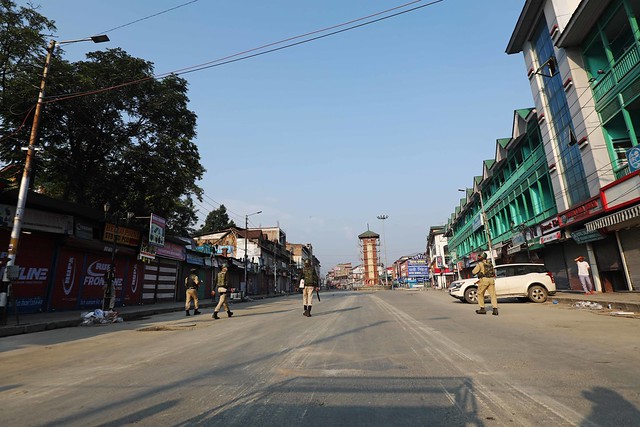Thursday, April 18, 2024
News and Views from the Global South
Human Rights
50 Days of Kashmir Under Lockdown – in Pictures

A boy pedals his bike along the desolated street of old city, which has been epicentre of protests and demonstrations. Credit: Umer Asif/IPS
- It is 50 days into the lockdown in Kashmir since roads were blocked off, schools shut, and internet and communication services stopped.
On Aug. 5, India’s federal government led by Prime Minister Narendra Modi imposed a curfew in the Muslim-majority area after amending the law to revoke the partial autonomy and statehood of Jammu and Kashmir. Restrictions on movement were immediately placed through a curfew as internet and telecommunications were cut.
The government also decreed that people from other Indian states could buy land in the region and become permanent citizens here.
Local Muslims, who form 80 percent of Kashmir’s 8 million people, feared that through such a move, the Indian government was trying to change the demography of the region.
More than 4,000 people, including politicians of opposition groups, human rights activists and separatists have since been detained by the government.
Though the government claimed that it is making attempts to restore normalcy and open schools, the efforts elicited no positive response from people as parents refuse to send their children to school for fear of violence. In a tweet the YFK-International Kashmir Lobby Group, a non-governmental human rights organisation, stated that the region’s economy had been devastated because of the clampdown.
Tourism in the region has been badly hit ever since the imposition of curfew by the Indian government. Hotels have zero occupancy and tourist resorts are deserted.
49 days of curfew#Jammu & #Kashmir‘s economy in tailspin pic.twitter.com/WdwogaHrRb
— Kashmir Lobby Group (@KashmirLobby) September 22, 2019
The Indian-administered part of Kashmir has experienced increased violence since 1989 when militants stepped up armed resistance here.
Rights groups estimate that 100,000 people have since been killed, but Indian official records put the number at 47,000.

Kashmiri has seen 50 days of imposed restrictions by the Indian government since it imposed a curfew in the Muslim-majority area after amending the law to revoke the partial autonomy and statehood of Jammu and Kashmir. The area also saw an increased military presence. Credit: Umer Asif/IPS

A boy pedals his bike along the desolated street of old city, which has been epicentre of protests and demonstrations. Credit: Umer Asif/IPS

An Indian paramilitary officer instructs his sub-ordinates about how to implement law and order in Kashmir’s capital Srinagar, as a curfew was imposed in the region. Credit: Umer Asif/IPS

As schools continue to remain shut in the region since Aug. 5, amounting to 50 days tomorrow, kids are being taught in make shift schools, established by local citizens in several areas of Kashmir. Credit: Umer Asif/IPS

A fleet of school busses parked in a garage in Srinagar outskirts as parents are reluctant to send their children to school due to the wave of uncertainty in Kashmir. Credit: Umer Asif/IPS

View of a desolated classroom of one of the schools in Kashmir. Schools, universities, colleges and government offices are all shut in the region. The government’s attempts to reopen schools have failed as parents are reluctant to send their children to school due to the wave of uncertainty. Credit: Umer Asif/IPS

The family of Asrar Ahmad, a 16-year-old boy who was killed during protests in the Illahi Bagh area of Srinagar. Ahmad succumbed to his injuries in hospital a month after being injured during protests. According to the family, Ahmad was hit by pellet guns fired by police, a claim vehemently rejected by the government. Credit: Umer Asif/IPS

A para-military trooper guarding the main door of Kashmir’s largest mosque, Jamia Masjid. No prayers have been allowed inside the mosque since Aug. 5. Credit: Umer Asif/IPS

Army men patrol one of the busiest markets of Srinagar, Kashmir’s capital, known popularly as Lal Chowk. Even as the government eased restrictions, locals continue to observe the strike against scraping of Kashmir’s autonomy. Credit: Umer Asif/IPS

A protester who was shot at with a pellet gun displays the X ray film showing the pellets that penetrated his body. He was protesting against the curfew the Indian government placed on Kashmir. Credit: Umer Asif/IPS

In the aftermath of protests. A road in Kashmir’s Anchaar area in the capital Srinagar. It’s the scene of pitched battles youth have had with the police on Aug. 5. Credit: Umer Asif/IPS

The Indian government put an end to large scale protests by revoking the autonomy of Indian-administered Kashmir – a status provided for under the Indian Constitution. Thousands of troops were deployed and the valley region faced unprecedented lockdown. Credit: Umer Asif/IPS

Amid the communication gag which includes an internet blockade, Kashmir’s journalistic fraternity were provided with a limited internet facility at a basement of a private hotel in Srinagar. It is from this place that IPS correspondents were able to file their reports and use the internet. Credit: Umer Asif/IPS

Shikaras — special boats used to take tourists to explore Kashmir’s mesmerising lakes — parked near on the bank of the world-famous Dal Lake. Tourism in the region has been badly hit ever since the imposition of curfew by the Indian government. Hotels have zero occupancy and tourist resorts too are deserted. Credit: Umer Asif/IPS

 Print
Print



